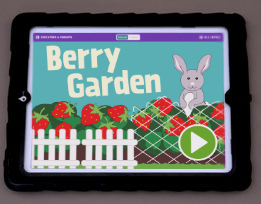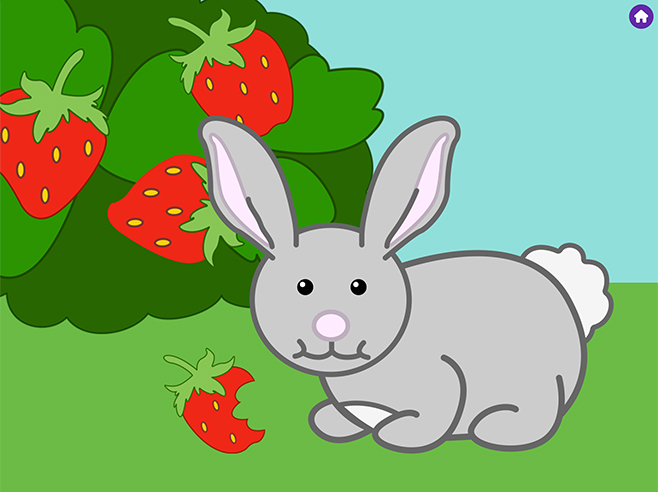Children visit a digital community garden and help protect the strawberries from being eaten by bunnies. They explore and test different materials as they design solutions to keep the bunnies away from the strawberry plants.
Materials

- Berry Garden app on iPads (1 device for Circle Time; 2–4 for Learning Centers)
- Projector (if available)
Preparation
- Familiarize yourself with levels 1–12 on the Berry Garden app.
- If you prefer to use the app without music during parts of the game, tap the pink “music” button to mute all music.
- Children are progressively challenged as they work through the Berry Garden app: 1) the number of strawberry plants to protect increases, 2) the material choices increase, and 3) the positioning of the materials to cover all the strawberry plants becomes more difficult.
- Levels 1–4. Introduce the app and explain how fences can protect the strawberries by stopping the bunnies from getting to the berry plants. Children use between 7 and 10 fences and protect 2 or 3 garden plants in each level.
- Levels 5–8. Introduce a new material children can use to protect the strawberries: nets. One net can protect all the sides of a berry plant. Children choose from a combination of fences and nets to find a solution that will protect varied arrangements of 2 or 3 berry plants in the garden.
- Levels 9–12. Children choose from a combination of fences and nets to find a solution that will protect varied arrangements of 4 to 6 berry plants in the garden.
Directions: Lesson 8
Circle Time: Introduction
This game is introduced in a whole-group activity. Use a projector or hold the iPad as you would a picture book for the group to see. Children will also explore the game independently or with a partner at the Learning Center.
Invite children to explore how they can help solve a problem in the berry garden: how to protect the berries from the bunnies who want to eat them. Have them listen as Nico introduces the Berry Garden app. Spark children’s curiosity: Are you ready to find a solution that will keep the bunnies out of the berry garden?
As you introduce and explore the Berry Garden game with children, engage the group in a conversation, using science and engineering discussion prompts such as those below.
- Hold up the app and read the title to introduce the Berry Garden game. Find out what children know about gardens. Possible discussion ideas:
- Do you know anyone who has a fruit or vegetable garden? Tell us about it.
- Have you ever helped take care of a garden? What did you do?
- Have children describe the opening screen.
- What do you see on the screen?
- How do you know the garden is outdoors? Why do you think gardens are planted outdoors? Elicit responses that include how outdoor environments have things plants need to live and grow (sun, air, soil, space, water).
- Why do you think there are fences and a net around the strawberries? Let’s find out!
- Tap the green button. Listen to Nico introduce the app and the problem children will solve.
- Levels 1–4. In Level 1, notice how Nico drags a fence from the materials box to close up the opening around the garden. Can the bunnies get in the garden now?
- Point out the pink dotted outline that goes around the berry plants.
- Trace the area where the outline appeared. Explain how the berry plants are unprotected and how placing fences around the outside of the plants will keep the bunnies from getting to the strawberries.
- Point out the space between the two berry plants. Why do you think this side does not need a fence? Discuss how the fences around the outside of the berry plants will block the bunnies from reaching this middle section.
- Ask a volunteer to drag a fence to one side of a berry plant.
- Does the fence block one side of a berry plant? Can the bunnies get in on that side?
- How many plants do we need to protect from the bunnies?
- Invite volunteers to continue to drag fences around the berry plants. If a child tries to place a fence on top of a berry plant, point out how the fence snaps back to the materials box. Possible discussion ideas:
- Did we protect the berries from the bunnies? Do we need more fences? Let’s test it.
- Point to the “bunny” button and tell children they can test their design to see if it works. Have a child tap the button. Here come the bunnies!
- If the solution does not work, point out the yellow outline that appears around the berry plant. Have a child revise the solution by adding a fence to protect the whole plant.
- Tap the bunny button to continue. Harvest the strawberries.
- How many strawberries are ready to be harvested?
- You might need to explain that “harvesting” is done at the time of year when the fruits and vegetables on the farm are fully grown and ready to be picked and gathered from the trees and fields.
- Continue to the next level. As you go through each level, prompt children to:
- Count the number of berry plants that need protection.
- Notice how the berry plants are arranged in the garden. Talk about how some berry plants need protection on all four sides, but sometimes when plants are right next to each other, the side in between the two plants is already protected.
- Count how many strawberries are ready to harvest.
Learning Center
- Encourage children to listen to and build on each other’s ideas as they explore the Berry Garden game in pairs or individually. Observe how children approach each level of the game, and use prompts such as those used during the whole-group explorations to engage children in science and engineering talk.
- Support children in thinking about cause and effect as they solve each level’s challenges, noting how some berry plants need protection on all four sides, but others do not. Discuss how different materials will provide different amounts of protection.
- What material will you use to close up that opening in the fence? Why ?
- How did the bunnies get to the berry plant? How do you think you can revise your design?
- How many sides of the plant do you have to protect? How many (fences/nets) do you have? Can you use that number of (fences/nets) to protect all the berry plants?
- Support children in thinking about what plants need to live and grow until harvest time.
- Why do you think gardens are planted in outdoor environments?
Directions: Lessons 9, 10, 11
Circle Time: Introduction
- Levels 5–12. In Level 5, a new material is introduced: nets. As Nico drags a net over a berry plant, notice how many sides the net protects.
- Invite a volunteer to trace around the plant covered by the net. How many sides does a net protect? How many sides does a fence protect?
- Have the child drag one of the nets to the berry plant. Tell children to think about how many sides they need to cover on each plant and where to place the nets so they do not run out before all the plants are protected.
- Drag another net onto an empty space in the garden. Invite a child to tap the bunny button to test the design.
- What happened? Why did the bunnies get into the berry plant?
- Have the child revise the solution by dragging the net over the berry plant and then tap the bunny button to test again. What happened this time? Were the strawberries protected?
- Harvest the strawberries.
- How many strawberries are ready to be harvested?
- Continue to the next level. As levels 5–12 progress, the number of berry plants in the garden and materials needed to solve the problem increase. Also, children will encounter more complex positioning of the berry plants in the garden, which will require more complex solutions. If needed, offer support through discussion ideas such as:
- How many berry plants are in this group? How many sides can the bunnies get in?
- Do you need to have a fence between those two plants? Why?
- Do you think you need to put a fence on the sides where there are bushes (or stones)? As you go through each level, prompt children to:
- Count the number of berry plants that need protection.
- Notice the materials available.
- Notice how the berry plants are arranged in the garden. Review how many berry plant sides a fence protects and a net protects.
- Count how many strawberries are ready to harvest.
Learning Center
- Encourage children to listen to and build on each other’s ideas as they explore the Berry Garden game in pairs or individually. Observe how children approach each level of the game, and use prompts such as those used during the whole-group explorations to engage children in science and engineering talk.
- Support children in thinking about cause and effect as they solve each level’s challenges, noting how some berry plants need protection on all four sides, but others do not. Discuss how different materials will provide different amounts of protection.
- What material will you use to close up that opening in the fence? Why ?
- How did the bunnies get to the berry plant? How do you think you can revise your design?
- How many sides of the plant do you have to protect? How many (fences/nets) do you have? Can you use that number of (fences/nets) to protect all the berry plants?
- Support children in thinking about what plants need to live and grow until harvest time.
- Why do you think gardens are planted in outdoor environments?
- What do plants need to live and grow?
Directions: Lesson 12
Learning Center
- Encourage children to listen to and build on each other’s ideas as they explore the Berry Garden game in pairs or individually. Observe how children approach each level of the game, and use prompts such as those used during the whole-group explorations to engage children in science and engineering talk.
- Support children in thinking about cause and effect as they solve each level’s challenges, noting how some berry plants need protection on all four sides, but others do not. Discuss how different materials will provide different amounts of protection.
- What material will you use to close up that opening in the fence? Why ?
- How did the bunnies get to the berry plant? How do you think you can revise your design?
- How many sides of the plant do you have to protect? How many (fences/nets) do you have? Can you use that number of (fences/nets) to protect all the berry plants?
- Support children in thinking about what plants need to live and grow until harvest time.
- Why do you think gardens are planted in outdoor environments?
- What do plants need to live and grow?


